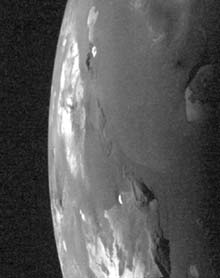From Jupiter’s Moon, Io, come ideas about what Earth may have looked like as a newborn planet

region on Jupiter’s moon Io may provide clues to what Earth looked like as a ’newborn’ planet, say researchers from UB and JPL (Photo: Courtesy NASA/JPL-Caltech). <br>
Lava lakes could be Ionian versions of Earth’s mid-ocean ridges
Investigations into lava lakes on the surface of Io, the intensely volcanic moon that orbits Jupiter, may provide clues to what Earth looked like in its earliest phases, according to researchers at the University at Buffalo and NASA’s Jet Propulsion Laboratory.
“When I look at the data, it becomes startlingly suggestive to me that this may be a window onto the primitive history of Earth,” said Tracy K. P. Gregg, Ph.D., assistant professor of geology in the UB College of Arts and Sciences.
“When we look at Io, we may be seeing what Earth looked like when it was in its earliest stages, akin to what a newborn baby looks like in the first few seconds following birth,” she added.
Gregg and Rosaly M. Lopes, Ph.D., research scientist at JPL, gave a presentation about Io’s volcano, Loki, on Tuesday (March 16, 2004) at the Lunar and Planetary Science Conference in Houston.
Scientists have been interested in Loki, considered the most powerful volcano in the solar system, because of debate over whether or not it is an active lava lake, where molten lava is in constant contact with a large reservoir of magma stored in the planet’s crust.
Using models developed to investigate temperature changes on active lava lakes on Earth, Gregg and Lopes have concluded that Loki behaves quite differently from terrestrial lava lakes.
Gregg suggests that Loki and other lava lakes on Io might be more similar volcanologically to fast-spreading mid-ocean ridges on Earth, like the Southern East Pacific Rise.
According to Gregg, plate tectonics on Earth make these features long — as in thousands of kilometers — and narrow — as in less than 10 kilometers wide. Io, on the other hand, has no plate tectonics and a similar release of heat and magma would be circular, like Loki.
“These lava lakes could be an Ionian version of mid-ocean ridges,” functioning the way these ridges do on Earth, spilling huge amounts of lava on its surface, thus generating new crust, she said.
During the most intense periods of its eruption cycle, Gregg said, Loki churns out about 1,000 square meters of lava — about the size of a soccer field — per second.
“All planets start out hot and spend their ’lifetimes’ trying to get cold,” explained Gregg.
This effort by planets to “chill,” she explained, is an attempt to attain a similar temperature to that of outer space, which is 4 Kelvin, or minus 269 degrees Celsius.
On Earth, she explained, the shifting of the planet’s tectonic plates, which focus the eruption of volcanoes at their boundaries, function to cool down the planet’s surface.
Io never developed plate tectonics because it is stuck in an incessant orbit between Jupiter and Europa, another of the Jovian planet’s moons.
“Io just never grew up,” she said, “since it’s continually being pushed around by Jupiter and Europa.”
But, she added, Earth only developed plate tectonics after it had been in existence for perhaps 200 to 500 million years.
Gregg and Lopes analyzed data obtained by the Galileo spacecraft, which orbited Jupiter for 14 years, finally disintegrating in Jupiter’s atmosphere last fall.
The University at Buffalo is a premier research-intensive public university, the largest and most comprehensive campus in the State University of New York.
Media Contact
All latest news from the category: Physics and Astronomy
This area deals with the fundamental laws and building blocks of nature and how they interact, the properties and the behavior of matter, and research into space and time and their structures.
innovations-report provides in-depth reports and articles on subjects such as astrophysics, laser technologies, nuclear, quantum, particle and solid-state physics, nanotechnologies, planetary research and findings (Mars, Venus) and developments related to the Hubble Telescope.
Newest articles

First-of-its-kind study uses remote sensing to monitor plastic debris in rivers and lakes
Remote sensing creates a cost-effective solution to monitoring plastic pollution. A first-of-its-kind study from researchers at the University of Minnesota Twin Cities shows how remote sensing can help monitor and…

Laser-based artificial neuron mimics nerve cell functions at lightning speed
With a processing speed a billion times faster than nature, chip-based laser neuron could help advance AI tasks such as pattern recognition and sequence prediction. Researchers have developed a laser-based…

Optimising the processing of plastic waste
Just one look in the yellow bin reveals a colourful jumble of different types of plastic. However, the purer and more uniform plastic waste is, the easier it is to…


